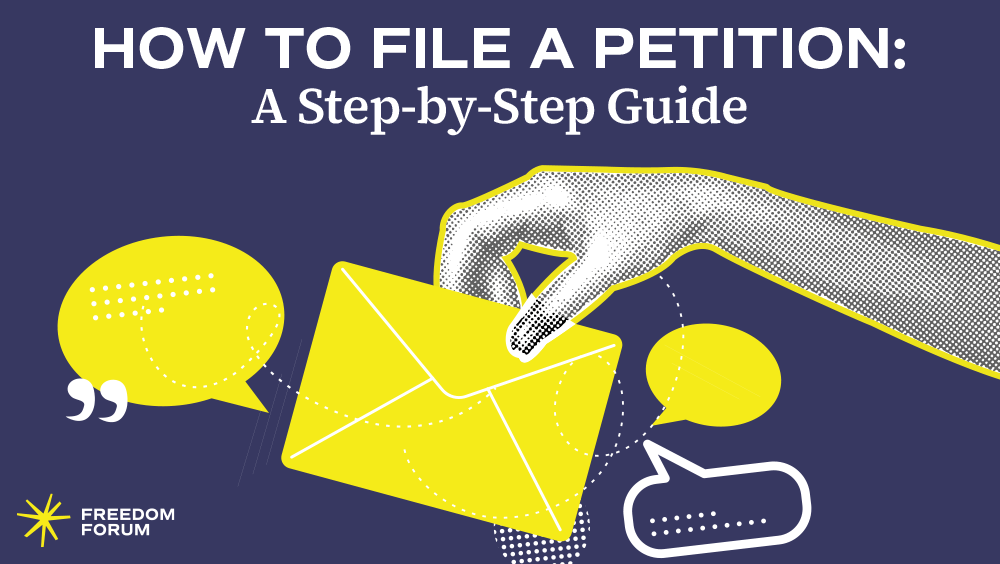How to File a Petition: A Step-by-Step Guide

Petition is one of the five freedoms guaranteed by the First Amendment. But what is it, exactly, and how can you exercise your constitutional right to “petition the government for a redress of grievances”?
Great question! This step-by-step guide on how to file a petition is here to help.
What is the freedom to petition under the First Amendment?
Compared to the other four freedoms – religion, speech, press and assembly – the right of petition is generally less understood. Freedom Forum’s annual “The First Amendment: Where America Stands” survey shows this. Only about 40% of Americans know petition is one of the five freedoms they have under the First Amendment.
The freedom of petition protects your right to ask the government to fix something, change a policy you don’t like or uphold a law that might be overturned. You can petition any branch of government at any level (federal, state or local), including courts.
Petition is not limited to submitting an online form or signing your name on paper. It includes any effort to ask the government for change – hence the phrase “petition the government for a redress of grievances” in the First Amendment.
Some examples include:
- Writing to your member of Congress to press for or oppose a new law.
- Asking your city council to add more bike lanes.
- Speaking before your local school board to request that libraries remove books or advocate against removing books.
- Filing a lawsuit against the state government for violating the state constitution.
- Seeking to put an initiative on the ballot that would repeal a state law or add a new one. (This resource lists state laws for seeking ballot measures.)
- Trying to remove an elected official through a recall election.
However, it’s important to remember: You’re allowed to petition government officials to ask for change, but those officials are not required to act on what you’re asking or to change policy the way you want. They just aren’t allowed to punish you or retaliate against you in any other way because you exercised your First Amendment right to petition.
Now that you know the purpose of a petition, here’s how to file one.
Discover how to file a petition in eight steps
Since petitions come in many forms and sizes (depending on what you want the government to do), there’s no one-size-fits-all approach to filing a petition.
Neither is there a convenient website where you can simply submit your name and have your idea (or your grievance) sent to any government official or court in the country.
These eight steps will help you think about what to do next as you consider the best way to exercise your First Amendment right. Think of each step as representing one letter in the word P.E.T.I.T.I.O.N: Prepare. Educate. Take action. Isolate. Treatment. Investigate. Open. Nail it.
Step 1: Prepare
Decide what you want to achieve.
Like making a rich dessert with lots of ingredients, you’ll need to prepare everything in advance. That means taking time to think through your idea and figure out how everything fits together, like a layered wedding cake.
For a petition, that means asking yourself these questions:
- What is it I want changed?
- Why is this action necessary?
- How long will it take to make the change I seek?
- Will the length of time involved mean the change I seek may not matter?
- What are examples of other successful and unsuccessful efforts similar to this one?
Step 2: Educate
Once you know what you want to achieve, you’ll need to find out whether it takes government action to change it. When it comes to exercising your First Amendment freedoms, education is key.
Petitions are broadly a form of asking people, groups, businesses, organizations or the government to do something. But the First Amendment covers only the kinds of petitions dealing with actions requested of government.
It’s possible your issue doesn’t involve an elected official or governmental body at all. For example, if you live in a homeowner’s association, the board of that private association is likely the official group to change policy related to lawn maintenance, but they are not a governmental body.
Similarly, a concern, complaint or request sent to the board of trustees that oversees a private university is not an example of exercising a First Amendment right of petition, though sending the same request to the same body at a public university would.
And though you may want a fast-food restaurant to bring back your favorite dropped menu item, that doesn’t involve a First Amendment-protected petition, either.
Step 3: Take action
Decide what person or agency within the government can enact the change you want.
Government can be complicated and comes in many layers – just like baking that multitiered wedding cake. An essential step in filing your petition is figuring out who in government can take action on your behalf.
That means connecting the issue you want addressed with the official or governmental body that has the power to change it.
These are some scenarios and the possible government officials to consider contacting or petitioning:
- You want to: Change federal tax code.
- Then you should petition: Your member of Congress.
- You want to: Change state gas tax.
- Then you should petition: Your state legislator.
- You want to: Add bike lanes in town.
- Then you should petition: Your city council member.
- You want to: Change school district policy on cellphones in classrooms.
- Then you should petition: Your school board member.
- You want to: Add an initiative to the ballot.
- Then you should petition: Your state election board.
These are just examples of ways to petition government and the kinds of officials you may want to contact.
Not only should you figure out who can act on your behalf, but you’ll need to take time to learn what kind of governmental body is able to address your concern.
The key questions to ask yourself in this step:
- Is this a local, state or federal issue?
- Does it require a new policy or law to be passed or a court to rule?
📝 GET STARTED: Take action with our Start a Petition tool 📝
Step 4: Isolate
Decide what kind of petition you need.
There’s no single way to petition the entire government, nor is there a single way to file one, so you’ll need to match what you want to achieve with the way to achieve it. Certain government bodies may have specific forms and/or specific rules for filing those forms – courts often have very specific filing requirements and formats – while others may simply allow you to write a letter.
Put another way: Isolate the one you need from all the possibilities.
Petitioning government could mean:
- Filling out a form that asks the government to grant you a right (such as for an immigration visa petition).
- Submitting a letter to your member of Congress about the need to update a law.
- Giving your input during an open period for a state agency making a new business regulation.
- Seeking a ballot measure or attempting to recall an elected official.
- Speaking at a public meeting during an open forum in front of elected officials.
- Filing a lawsuit seeking to prevent a law or regulation from going into effect or being enforced.
Step 5: Treatment
Make your case and write it down.
It’s like writing a detailed pitch for a movie or TV show in Hollywood, also called a treatment. This is where you make your case for what you want to achieve.
You can outline your case using the "5Ws and 1H” method common in journalism:
- What is the issue I am trying to address?
- Who is the government official or body able to address this?
- Where is the place to direct my petition?
- When is the ideal time to submit it to make sure people can see and act on it?
- Why is this issue important to take on among all the other issues people request of government?
- How will I enlist help from others and publicize my efforts to reach a wider audience?
Step 6: Investigate
Collect all the materials you need.
Like a journalist, police detective, prosecutor or defense attorney, you’ll need to collect evidence and investigate.
Depending on the type of petition you’re making, this may include:
- Researching whether your petition requires signatures from registered voters.
- Evidence of wrongdoing by a public official.
- News articles that relate to the topic of your petition.
- Documents related to the case you’re making.
- Public records that you have requested and obtained through a formal request.
(Here is a guide from the National Freedom of Information Coalition on requesting public records in every state.)
Step 7: Open
Some types of petitions only take one person to file them. But other types could require a certain number of signatures. Either way, others may have the same idea as you. In other words: open the process for collaborators.
This may be the time when you first go public with your petition. It could involve standing in a public place and attempting to gather signatures and talk to people about your cause.
It could also involve launching an online petition from platforms like Change.org, iPetitions or Jotform that can help you gather like-minded people for your cause.
Step 8: Nail it
Or perhaps more like mail it to the correct person in government.
Don’t be like Martin Luther and literally nail your grievance to a building door. In Luther’s case, his 95 theses were grievances against the Catholic Church, sparking the Protestant Reformation in 1517.
But like Luther, you can’t have your grievances addressed (or “redressed”) by the government if you don’t deliver them.
This is the time to take your complaint, idea, or request and give it to the appropriate elected official or governmental body. In most cases, that might be an email or mailed letter to the official. If your petition involves a court filing, you will need to go through the formal and official channels to do so (which could involve hiring a lawyer).
Now you know how to file a petition!
The ability to petition the government is protected by the First Amendment, just like the freedoms of religion, speech, press and assembly. But like those other freedoms, there are some limits to petition. Filing a petition or asking your elected official to change something does not guarantee they will.
If you think it’s daunting or impossible to change a law, or that elected officials won’t listen to you, remember that many forms of change — and new laws altogether — have come about through people using their First Amendment rights to gather, speak their minds and petition their government.
This guide on how to file a petition was compiled based on previously published Freedom Forum content by staff writer Scott A. Leadingham. He can be reached at sleadingham@freedomforum.org.
2024 Free Spirit Scholar: Shannon Raneri
Ink Expression: Tattoos and Free Speech
Related Content

